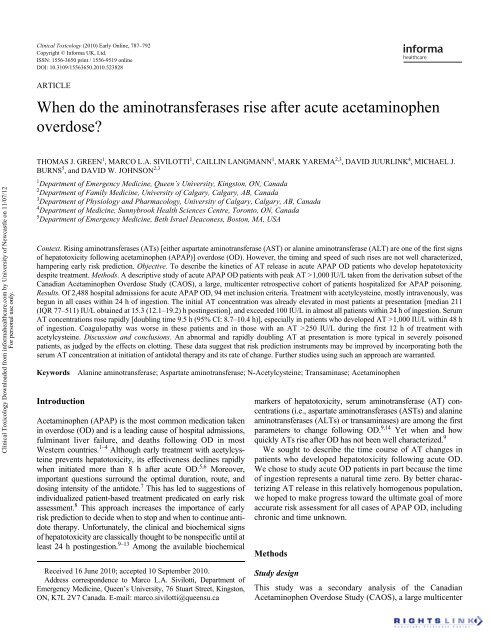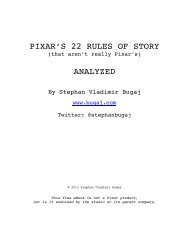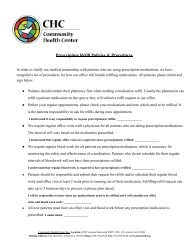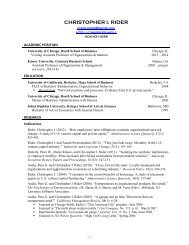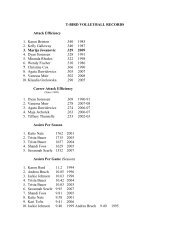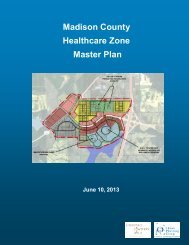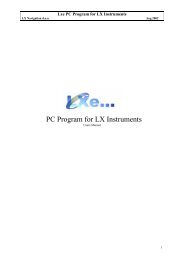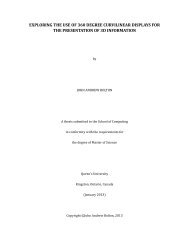When do the aminotransferases rise after acute ... - Squarespace
When do the aminotransferases rise after acute ... - Squarespace
When do the aminotransferases rise after acute ... - Squarespace
Create successful ePaper yourself
Turn your PDF publications into a flip-book with our unique Google optimized e-Paper software.
Clinical Toxicology (2010) Early Online, 787–792Copyright © Informa UK, Ltd.ISSN: 1556-3650 print / 1556-9519 onlineDOI: 10.3109/15563650.2010.523828LCLTARTICLE<strong>When</strong> <strong>do</strong> <strong>the</strong> <strong>aminotransferases</strong> <strong>rise</strong> <strong>after</strong> <strong>acute</strong> acetaminophenover<strong>do</strong>se?Clinical Toxicology Downloaded from informahealthcare.com by University of Newcastle on 11/07/12For personal use only.<strong>When</strong> <strong>do</strong> <strong>the</strong> AT <strong>rise</strong> <strong>after</strong> APAP OD?THOMAS J. GREEN 1 , MARCO L.A. SIVILOTTI 1 , CAILLIN LANGMANN 1 , MARK YAREMA 2,3 , DAVID JUURLINK 4 , MICHAEL J.BURNS 5 , and DAVID W. JOHNSON 2,31 Department of Emergency Medicine, Queen’s University, Kingston, ON, Canada2 Department of Family Medicine, University of Calgary, Calgary, AB, Canada3 Department of Physiology and Pharmacology, University of Calgary, Calgary, AB, Canada4 Department of Medicine, Sunnybrook Health Sciences Centre, Toronto, ON, Canada5 Department of Emergency Medicine, Beth Israel Deaconess, Boston, MA, USAContext. Rising <strong>aminotransferases</strong> (ATs) [ei<strong>the</strong>r aspartate aminotransferase (AST) or alanine aminotransferase (ALT) are one of <strong>the</strong> first signsof hepatotoxicity following acetaminophen (APAP)] over<strong>do</strong>se (OD). However, <strong>the</strong> timing and speed of such <strong>rise</strong>s are not well characterized,hampering early risk prediction. Objective. To describe <strong>the</strong> kinetics of AT release in <strong>acute</strong> APAP OD patients who develop hepatotoxicitydespite treatment. Methods. A descriptive study of <strong>acute</strong> APAP OD patients with peak AT >1,000 IU/L taken from <strong>the</strong> derivation subset of <strong>the</strong>Canadian Acetaminophen Over<strong>do</strong>se Study (CAOS), a large, multicenter retrospective cohort of patients hospitalized for APAP poisoning.Results. Of 2,488 hospital admissions for <strong>acute</strong> APAP OD, 94 met inclusion criteria. Treatment with acetylcysteine, mostly intravenously, wasbegun in all cases within 24 h of ingestion. The initial AT concentration was already elevated in most patients at presentation [median 211(IQR 77–511) IU/L obtained at 15.3 (12.1–19.2) h postingestion], and exceeded 100 IU/L in almost all patients within 24 h of ingestion. SerumAT concentrations rose rapidly [<strong>do</strong>ubling time 9.5 h (95% CI: 8.7–10.4 h)], especially in patients who developed AT >1,000 IU/L within 48 hof ingestion. Coagulopathy was worse in <strong>the</strong>se patients and in those with an AT >250 IU/L during <strong>the</strong> first 12 h of treatment withacetylcysteine. Discussion and conclusions. An abnormal and rapidly <strong>do</strong>ubling AT at presentation is more typical in severely poisonedpatients, as judged by <strong>the</strong> effects on clotting. These data suggest that risk prediction instruments may be improved by incorporating both <strong>the</strong>serum AT concentration at initiation of anti<strong>do</strong>tal <strong>the</strong>rapy and its rate of change. Fur<strong>the</strong>r studies using such an approach are warranted.KeywordsIntroductionAlanine aminotransferase; Aspartate aminotransferase; N-Acetylcysteine; Transaminase; AcetaminophenAcetaminophen (APAP) is <strong>the</strong> most common medication takenin over<strong>do</strong>se (OD) and is a leading cause of hospital admissions,fulminant liver failure, and deaths following OD in mostWestern countries. 1–4 Although early treatment with acetylcysteineprevents hepatotoxicity, its effectiveness declines rapidlywhen initiated more than 8 h <strong>after</strong> <strong>acute</strong> OD. 5,6 Moreover,important questions surround <strong>the</strong> optimal duration, route, and<strong>do</strong>sing intensity of <strong>the</strong> anti<strong>do</strong>te. 7 This has led to suggestions ofindividualized patient-based treatment predicated on early riskassessment. 8 This approach increases <strong>the</strong> importance of earlyrisk prediction to decide when to stop and when to continue anti<strong>do</strong>te<strong>the</strong>rapy. Unfortunately, <strong>the</strong> clinical and biochemical signsof hepatotoxicity are classically thought to be nonspecific until atleast 24 h postingestion. 9–13 Among <strong>the</strong> available biochemicalmarkers of hepatotoxicity, serum aminotransferase (AT) concentrations(i.e., aspartate <strong>aminotransferases</strong> (ASTs) and alanine<strong>aminotransferases</strong> (ALTs) or transaminases) are among <strong>the</strong> firstparameters to change following OD. 9,14 Yet when and howquickly ATs <strong>rise</strong> <strong>after</strong> OD has not been well characterized. 9We sought to describe <strong>the</strong> time course of AT changes inpatients who developed hepatotoxicity following <strong>acute</strong> OD.We chose to study <strong>acute</strong> OD patients in part because <strong>the</strong> timeof ingestion represents a natural time zero. By better characterizingAT release in this relatively homogenous population,we hoped to make progress toward <strong>the</strong> ultimate goal of moreaccurate risk assessment for all cases of APAP OD, includingchronic and time unknown.MethodsReceived 16 June 2010; accepted 10 September 2010.Address correspondence to Marco L.A. Sivilotti, Department ofEmergency Medicine, Queen’s University, 76 Stuart Street, Kingston,ON, K7L 2V7 Canada. E-mail: marco.sivilotti@queensu.caStudy designThis study was a secondary analysis of <strong>the</strong> CanadianAcetaminophen Over<strong>do</strong>se Study (CAOS), a large multicenter
Clinical Toxicology vol. 48 no. 8 2010788 T.J. Green et al.Clinical Toxicology Downloaded from informahealthcare.com by University of Newcastle on 11/07/12For personal use only.retrospective medical record review of patients hospitalizedfor APAP poisoning. 6,7 Research ethics board approval for<strong>the</strong> parent study was granted at each participating institution.We analyzed only <strong>the</strong> data from <strong>the</strong> first one-third of patientsentered into <strong>the</strong> database, which represent <strong>the</strong> derivation subsetfor this and o<strong>the</strong>r analyses. 6,15 For this study, we selecte<strong>do</strong>nly those patients presenting within 1 day of a single, <strong>acute</strong>APAP OD and who developed hepatotoxicity.Study setting and populationThe CAOS identified all patients hospitalized for APAP ODin 34 Canadian hospitals between 1980 and 2005 based onelectronic search of discharge diagnoses. 6,7 Subjects wereincluded in this study if <strong>the</strong>y developed hepatotoxicity,defined as having a peak serum AST or ALT greater than1,000 IU/L at any point. 3,11,16 We excluded <strong>the</strong> subjects withany of <strong>the</strong> following: uncertainty regarding ingestion time ormultiple ingestions over >6 h, no serum APAP concentrationmeasured ≤24 h postingestion, no serum AST or ALT concentrationmeasured >24 h postingestion, preexisting hepaticinjury, or delayed presentation (as defined previously). 6Measurements and definitionsWe recorded every measured serum APAP, AST, ALT, prothrombintime, and international normalized ratio (INR) into<strong>the</strong> CAOS dataset. The time of ingestion was ascertained bycareful review of all pre-hospital, emergency department, andin-patient records. <strong>When</strong> ei<strong>the</strong>r a time interval or multiplesingle times were recorded, <strong>the</strong> earliest time was taken as <strong>the</strong>time of ingestion. Because some patients had only AST oronly ALT concentrations measured, <strong>the</strong> term AT is usedthroughout this article. For patients in whom both AST andALT were measured, <strong>the</strong> greater of <strong>the</strong> two values wasused. All AT concentrations measured <strong>after</strong> <strong>the</strong> criterion ofAT >1,000 IU/L had been attained were not considered fur<strong>the</strong>rin this analysis.Data analysisSerum AT kinetics were first characterized by <strong>the</strong> predictedtime, postingestion, to reach 1,000 IU/L. This time was estimatedfor each subject using <strong>the</strong> two consecutive AT concentrationsspanning 1,000 IU/L, assuming first-order kinetics.Patients were <strong>the</strong>n grouped according to <strong>the</strong> time intervalpostingestion needed for <strong>the</strong> AT to reach 1,000 IU/L (≤24,24–48, 48–72, and >72 h postingestion). This grouping wasestablished a priori and was based on <strong>the</strong> hypo<strong>the</strong>sis thatearlier <strong>rise</strong>s in AT are associated with less favorable clinicaloutcomes.We <strong>the</strong>n characterized <strong>the</strong> <strong>do</strong>ubling velocity (i.e., <strong>the</strong> firstorderrate constant) when AT crossed 1,000 IU/L. To combine<strong>the</strong> individual rate estimates into a population rate,a pooled approach was used ra<strong>the</strong>r than simply taking <strong>the</strong>unweighted average of <strong>the</strong> individual rates. 17,18 This techniqueallows for <strong>the</strong> nonexperimental nature of <strong>the</strong> data and isdesigned to limit <strong>the</strong> influence of outliers. The timed consecutiveAT concentrations spanning 1,000 IU/L for each subjectwere laterally translated to cross <strong>the</strong> time = 0 axis at apredicted AT of 1,000 IU/L. A single least squares regressionline was <strong>the</strong>n fitted through all <strong>the</strong> available data points toestimate <strong>the</strong> population <strong>do</strong>ubling velocity. 18 Because eachsubject contributed two data points to <strong>the</strong> analysis, <strong>the</strong> influenceof clustering within <strong>the</strong> dataset was considered to beminor. Rates of <strong>do</strong>ubling and <strong>the</strong> 95% confidence intervalsare expressed as <strong>the</strong> equivalent <strong>do</strong>ubling times throughout. Incases where <strong>the</strong> first AT above 1,000 was reported to be, forexample, “>1,200” and fur<strong>the</strong>r dilutions were not performed,<strong>the</strong> AT concentration was assigned to this lower limit.Summary statistics are reported throughout, as <strong>the</strong>re was noapriori null hypo<strong>the</strong>sis to be tested.ResultsSubjects were selected from <strong>the</strong> derivation subset of <strong>the</strong> first3,202 admissions in <strong>the</strong> CAOS database as of February 2003.Of <strong>the</strong>se, 2,488 resulted from a single, <strong>acute</strong> APAP ingestion.We excluded 196 subjects because no serum APAP was measuredwithin 24 h of ingestion and excluded 1,012 because noserum AT was measured beyond 24 h following ingestion. Of<strong>the</strong> remaining 1,280 <strong>acute</strong> APAP ODs with sufficient laboratorydata for consideration, 10 were excluded because ofpreexisting hepatic injury [initial AT>100 IU/L, APAP concentrationmore than 70% below <strong>the</strong> 1,000 μmol/L (150mg/L) line, and peak AT less than two times <strong>the</strong> initial value]or delayed presentation (undetectable APAP at presentationand AT>1,000 IU/L regardless of reported time of ingestion).The characteristics of <strong>the</strong>se patients have been reportedpreviously. 6 For this analysis, we retained only <strong>the</strong> 94 patients(7.4%) who developed hepatotoxicity (peak serum AST orALT ≥1,000 IU/L) (Table 1). All of <strong>the</strong>se 94 patients weretreated with acetylcysteine, initiated a median of 15.5h[interquartile range (IQR) 12.3, 18.4] postingestion. The 20-hPrescott intravenous protocol 16 was initiated in all but threecases and extended beyond 24 h in one-third of cases. Thefirst post-4 h APAP concentration exceeded <strong>the</strong> 1,000 μmol/L (150 μg/mL) at 4h treatment line of <strong>the</strong> Rumack–Mat<strong>the</strong>wnomogram in all cases (Fig. 1). None of <strong>the</strong>se patients, all ofwhom were treated with acetylcysteine within 24 h of <strong>acute</strong>OD, died and only one underwent liver transplant.AT concentrations were measured at 707 different timepoints [median 73 h (IQR 34–118 h)] postingestion, up to andincluding <strong>the</strong> first AT >1,000 IU/L. Both AST and ALT weremeasured at 413 of <strong>the</strong>se time points [median ratio 1.32 (IQR1.19–1.52)]. The first measured AT concentration averaged211 IU/L (median, IQR 77–511 IU/L; range 8 to > 5,200 IU/L)and collected at a median of 15.3h (IQR 12.1–19.2 h)
Clinical Toxicology vol. 48 no. 8 2010<strong>When</strong> <strong>do</strong> <strong>the</strong> AT <strong>rise</strong> <strong>after</strong> APAP OD? 789Table 1. Characteristics of <strong>acute</strong> over<strong>do</strong>se patients with hepatotoxicity (study group) compared with those withou<strong>the</strong>patotoxicityMedian (IQR) or count (percentage) Hepatotoxicity (n = 94) No hepatotoxicity (n = 1176)Age (year) 23.7 (18.4, 36.3) 21.9 (17.1, 31.8)Female (%) 57 (60.6) 819 (69.6%)Ethanol coingested (%) 19 (20.2) 347 (29.5%)Alcoholic (%) 19 (20.2) 191 (16.2%)Initial serum aminotransferase (IU/L) 211 (77, 511) 19 (14, 27)4-h serum acetaminophen equivalent a (μmol/L) 4,030 (2,340, 6,250) 1,350 (961, 1,960)Time to first measured acetaminophen (h) 14.9 (11.2, 17.3) 5.1 (3.7, 9.3)Time to acetylcysteine postingestion (h) 15.5 (12.3, 18.4) 7.8 (5.9, 11.6)Clinical Toxicology Downloaded from informahealthcare.com by University of Newcastle on 11/07/12For personal use only.Serum acetaminophen (µmol/L)10,0001,000Only <strong>acute</strong> over<strong>do</strong>se patients with serum acetaminophen measured within 24 h of over<strong>do</strong>se and with serum AT measured at least24-h postover<strong>do</strong>se are included. Hepatotoxicity is defined as a peak AT >1,000 IU/L.a The “4-h serum acetaminophen equivalent” measures <strong>the</strong> vertical distance of <strong>the</strong> first measured acetaminophen concentrationabove <strong>the</strong> treatment line of <strong>the</strong> Rumack–Mat<strong>the</strong>w nomogram.1000 4 8 12 16 20 24Time from ingestion (h)Fig. 1. Initial serum acetaminophen concentration following <strong>acute</strong>over<strong>do</strong>se in subjects who developed aminotransferase concentrationsover 1,000 IU/L despite treatment. The gray line denotes <strong>the</strong> 1,000μmol/L (150 μg/mL) at 4 h treatment line of <strong>the</strong> Rumack–Mat<strong>the</strong>wnomogram.postingestion. Almost all AT concentrations measured 12 ormore hours postingestion exceeded 50 IU/L and exceeded100 IU/L when measured more than 24 h postingestion (Fig. 2).<strong>When</strong> considered relative to <strong>the</strong> start of acetylcysteine,serum AT concentrations were usually much higher than100 IU/L at <strong>the</strong> start of treatment and rose above 100 IU/Lin all but three cases during <strong>the</strong> first 20 h of anti<strong>do</strong>tal <strong>the</strong>rapy(Fig. 3).The predicted time to reach 1,000 IU/L could be establishedin 93 subjects. This traditional criterion for hepatotoxicity wasattained by 24 h postingestion in 19 subjects (20%), by 48 h in62 (67%), and by 72 h in 87 (94%). The AT <strong>do</strong>ubling timesgrouped by <strong>the</strong> time interval for AT to reach 1,000 IU/L areshown in Table 2. The serum AT <strong>do</strong>ubling time was substantiallyshorter, averaging less than 8 h among subjects attainingan AT concentration of 1,000 IU/L within 48 h of ingestion.Coagulopathy, as measured by peak INR, was also morecommon and severe in <strong>the</strong>se patients (Fig. 4). Patients whoSerum aminotransferase (IU/L)10,0001,000100100 24 48 72 96Time from acetaminophen ingestion (h)Fig. 2. Serum aminotransferase concentrations following <strong>acute</strong>over<strong>do</strong>se in patients who develop hepatotoxicity despite treatmentwith acetylcysteine. Timed serum aminotransferase concentrationsup to and including <strong>the</strong> first concentration >1,000 IU/L are shownfor individual subjects.Serum AST or ALT (IU/L)10,0001,00010010−12 0 12 24 36 48 60 72Time relative to acetylcysteine start (h)Fig. 3. Serum AST and ALT concentrations expressed relative to<strong>the</strong> initiation of treatment with acetylcysteine. Timed serum ASTand ALT concentrations are shown relative to <strong>the</strong> initiation ofanti<strong>do</strong>tal <strong>the</strong>rapy. In cases where both AST and ALT are measuredsimultaneously, both values are shown joined by a thick vertical line.
Clinical Toxicology vol. 48 no. 8 2010792 T.J. Green et al.Clinical Toxicology Downloaded from informahealthcare.com by University of Newcastle on 11/07/12For personal use only.10. Rumack BH. Acetaminophen misconceptions. Hepatology 2004;40(1):10–15.11. Rumack BH, Peterson RC, Koch GG, Amara IA. Acetaminophen over<strong>do</strong>se.662 cases with evaluation of oral acetylcysteine treatment. ArchIntern Med 1981; 141(3 Spec No):380–385.12. Lee WM. Drug-induced hepatotoxicity. N Eng J Med 2003;349(20):1975–1976.13. Woo OF, Mueller PD, Olson KR, Anderson IB, Kim SY. Shorter durationof oral N-acetylcysteine <strong>the</strong>rapy for <strong>acute</strong> acetaminophen over<strong>do</strong>se.Ann Emerg Med 2000; 35(4):363–368.14. Prescott LF, Roscoe P, Wright N, Brown SS. Plasma-paracetamol halflifeand hepatic necrosis in patients with paracetamol over<strong>do</strong>sage.Lancet 1971; 1(7698):519–522.15. Sivilotti MLA, Good AM, Yarema MC, Juurlink DN, Johnson DW.A new predictor of toxicity following acetaminophen over<strong>do</strong>se: beyond<strong>the</strong> nomogram. J Toxicol Clin Toxicol 2005; 43(4):229–234.16. Prescott LF, Illingworth RN, Critchley JA, Stewart MJ, Adam RD,Proudfoot AT. Intravenous N-acetylcysteine: <strong>the</strong> treatment of choicefor paracetamol poisoning. Br Med J 1979; 2(6198):1097–1100.17. Sivilotti ML, Burns MJ, McMartin KE, Brent J. Toxicokinetics of ethyleneglycol during fomepizole <strong>the</strong>rapy: implications for management.For <strong>the</strong> Methylpyrazole for Toxic Alcohols Study Group. Ann EmergMed 2000; 36(2):114–125.18. Sheiner LB, Ludden TM. Population pharmacokinetics/dynamics.Annu Rev Pharmacol Toxicol 1992; 32:185–209.19. Rumack BH, Mat<strong>the</strong>w H. Acetaminophen poisoning and toxicity.Pediatrics 1975; 55(6):871–876.20. Gregory B, Larson AM, Reisch J, Lee WM. Acute Liver Failure StudyGroup. Acetaminophen <strong>do</strong>se <strong>do</strong>es not predict outcome in acetaminophen-induced<strong>acute</strong> liver failure. J Investig Med 2010; 58(5):707–710.21. Pakravan N, Simpson KJ, Waring WS, Bates CM, Bateman DN. Renalinjury at first presentation as a predictor for poor outcome in severeparacetamol poisoning referred to a liver transplant unit. Eur J ClinPharmacol 2009; 65(2):163–168.22. Wallace CI, Dargan PI, Jones AL. Paracetamol over<strong>do</strong>se: an evidencebased flowchart to guide management. Emerg Med J 2002; 19(3):202–205.23. Thanacoody HKR, Good AM, Waring WS, Bateman DN. Survey of casesof paracetamol over<strong>do</strong>se in <strong>the</strong> UK referred to National Poisons InformationService (NPIS) consultants. Emerg Med J 2008; 25(3):140–143.24. Rhyee SH, Hoppe J, Heard K. Multiple transaminase peaks following<strong>acute</strong> acetaminophen over<strong>do</strong>se (abstract). Clin Toxicol 2007; 45(6):607.25. O’Grady JG, Alexander GJ, Hayllar KM, Williams R. Early indicatorsof prognosis in fulminant hepatic failure. Gastroenterology 1989;97(2):439–445.26. Gregory B, Larson AM, Reisch J, Lee WM, Acute Liver FailureStudy Group. Acetaminophen <strong>do</strong>se <strong>do</strong>es not predict outcome inacetaminophen-induced <strong>acute</strong> liver failure. J Investig Med 2010;58(5):707–710.27. Bailey B, Amre DK, Gaudreault P. Fulminant hepatic failure secondaryto acetaminophen poisoning: a systematic review and meta-analysis ofprognostic criteria determining <strong>the</strong> need for liver transplantation. CritCare Med 2003; 31(1):299–305.28. Harrison PM, O’Grady JG, Keays RT, Alexander GJ, Williams R.Serial prothrombin time as prognostic indicator in paracetamolinduced fulminant hepatic failure. BMJ 1990; 301(6758):964–966.29. Dargan PI, Jones AL. Management of paracetamol poisoning. TrendsPharmacol Sci 2003; 24(4):154–157.30. Smith SW, Howland MA, Hoffman RS, Nelson LS. Acetaminophenover<strong>do</strong>se with altered acetaminophen pharmacokineticsand hepatotoxicity associated with premature cessation of intravenousN-acetylcysteine <strong>the</strong>rapy. Ann Pharmaco<strong>the</strong>r 2008; 42(9):1333–1339.31. Halcomb SE, Sivilotti ML, Goklaney A, Mullins ME. Pharmacokineticeffects of diphenhydramine or oxyco<strong>do</strong>ne in simulated acetaminophenover<strong>do</strong>se. Acad Emerg Med 2005; 12(2):169–172.32. Doyon S, Klein-Schwartz W. Hepatotoxicity despite early administrationof intravenous N-acetylcysteine for <strong>acute</strong> acetaminophen over<strong>do</strong>se.Acad Emerg Med 2009; 16(1):34–39.33. Sivilotti MLA, Green TJ, Langmann C, Yarema MC, Juurlink DN,Johnson DW. Multiplying <strong>the</strong> serum aminotransferase by <strong>the</strong> acetaminophenconcentration to predict toxicity following over<strong>do</strong>se. ClinToxicol. Submitted for publication.


